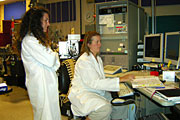- Number 328 |
- January 10, 2011
NanoSIMS suggests arsenic as a life building block

LLNL's Jennifer Pett-Ridge, right,
runs the NanoSIMS and analyzes
some arsenic-grown cells from
Mono Lake as NASA/USGS's
Felisa Wolfe-Simon observes.
Arsenic -- an element that triggers death for most Earthly life forms -- is actually allowing for bacterium to thrive and reproduce.
In a study that may prompt the rewriting of textbooks, a team of astrobiologists and chemists has found the first known living organism that can use arsenic in place of phosphorus in its major macromolecules. The new findings, published in the Dec. 2 issue of Science Express, could redefine origins of life research and alter the way we describe life as we know it.
Oxygen, carbon, hydrogen, nitrogen, sulfur and phosphorous are the six basic building blocks of life on Earth. These elements make up nucleic acids, proteins and lipids -- the bulk of living matter.
The new study by DOE's Lawrence Livermore National Laboratory and led by NASA and the U.S. Geological Survey has found that a bacterium isolated from Mono Lake may substitute arsenic for phosphorus to sustain its growth.
Mono Lake, located in eastern California, is an alkaline and hypersaline lake with high dissolved arsenic concentrations and is believed to have formed more than 760,000 years ago from neighboring volcanic eruptions.
LLNL's Jennifer Pett-Ridge and Peter Weber were able to identify low concentrations of arsenic found in individual cells of bacteria and extracted DNA by using the Lab’s Nano SIMS.
NanoSIMS is a tool which allows precise, spatially explicit, elemental and isotopic analysis down to the 50-nanomenter scale; it also offers a range of advantages for sensitive and high-resolution measurements.
NanoSIMS not only measures the elemental concentrations, but it also images them. It collects a picture of the image and identifies how much of a specific element is found in the sample. "We found that arsenic was higher in the cells than in the environment outside the cells," Pett-Ridge said.[Lynda Seaver, 925.423.3103
seaver1@llnl.gov]
